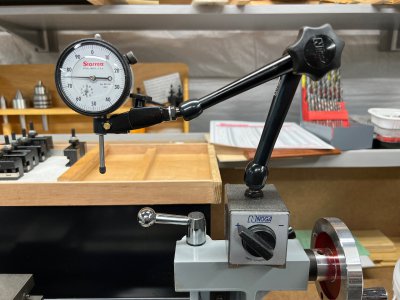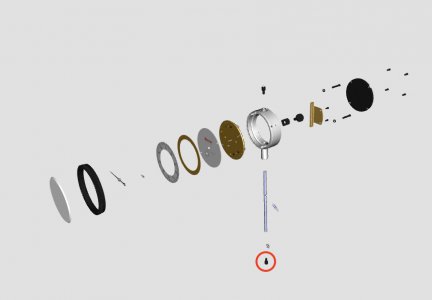I bought this Fowler dial indicator off of Amazon. First, seeing it in person, the numbers on the dial are small. Even in the pic below they don't look small. My eyes are not the greatest but I don't need glasses.
I'm right there with you. I don't need glasses, but not perfect in close. I've come to like using cheap "reader" glasses as genera purpose eye cover when I'm doing anything where that's appropriate. Don't get me wrong, when chips of anything are flying, "real" ones are still required, but the "general principal, glasses on" stuff... Next time you're at Walmart (or any department store), try looking at an ingredients label, or safety warning, or any small text on anything in your cart, at a comfortable distance... If you can "fix" something with that..... It's one of the cheapest shop tools you'll ever find. And if it's not the problem, it won't cost but two minutes to know that too.
And I do agree, it almost always looks like bigger, better, bolder graduations when you're looking at a picture, lit up on a computer screen. On that particular one, I "think" I like that outer dial. The reverse numbers look very convenient. None of mine have that. While it's in no way necessary, I think I might enjoy that feature.
Second, the revolution dial is not the same. The Amazon picture shows it as being one revolution per inch. The one I got is two revs per inch. The indicator itself looks the same as others, just rebranded with different names. And in the comments of a few of them they mention the same thing about the rev dial and not being the same as pictured.
I do have one of those. You've got to remember and pay attention to it, but after a few uses, it sorts it's self out and becomes more intuitive. I still like a one inch sub dial better, but either one works after you remember to remember. It's a large enough difference that if you forget, you'll figure it out before the tool hits the work.
Being new to this, and I being too picky? This Fowler one for $38 is in my price range. I'm not springing for something more expensive for starting out. After looking at others on Amazon, don't think I'm going to find one that fits my idea of what it should be. Thinking of returning it but wanted to ask for advice here first. I could try to go outside of Amazon to find what I want. Thoughts? And thank you from a newbie.
Too picky? That becomes pretty subjective when you're looking at entry level "metrology" stuff. And I'm right there with you. I can't have all good name top shelf stuff, so I'm right there swimming in the toilet with you, trying not to fall into the whirlpool..... My personal opinion on it is this- You're looking for a "compromise" price point tool, so there will be compromise. Not "cheap", but not "expensive". My way to go about deciding what to do is to just set up some arbitrary thing to measure, and use the thing for a few minutes. Does it operate smoothly, and repeat exactly? Well, the doors to owning an indicator open at about 20 bucks. If yours is smooth and consistent, then your price point is WAY more than justified by that feature alone. I'd keep it. I do own a couple of Harbor Freight dial indicators, and while they do have the full one inch sub dial, which I really like, they're not smooth, and don't "necessarily" repeat well. Although sometimes they do. Something's "sticky" if the tip is not 100 percent dead nutz exactly 90 degrees to the point of contact. One is worse than the other. And both will "jump" more than I'd expect when sweeping left to right, and then right to left. I'd expect "some", but one of these is in the 0.007 inch range. The other might be in the 0.003 range. To SOME degree, this is expected, and will happen, and it's kind of like backlash in a lathe dial. You know it's there, you only count graduations in one direction, and at that point it's pretty irrelevent. But at that large of a degree, it makes it hard to trust. If you find that this indicator works as I describe mine, at half the price.... I'd sent it back and spend half the money for the same thing. Or try a different brand in the same price point you're at. You can expect WAY better than I describe at your "cheap but not the cheapest" price point range.
Honestly, if you think that one operates smooth, repeatable, and generally is an OK measuring tool.... Despite the fact that like you, I'm not crazy about the dial, I might order one just so I can relegate my worst Harbor Freight one to the rod straightening contraption I've got on the shop press. Which of course is a little bit science, and a little bit black magic, so the crappy indicator would be more than fine there, and probably live a long, happy life that way.





